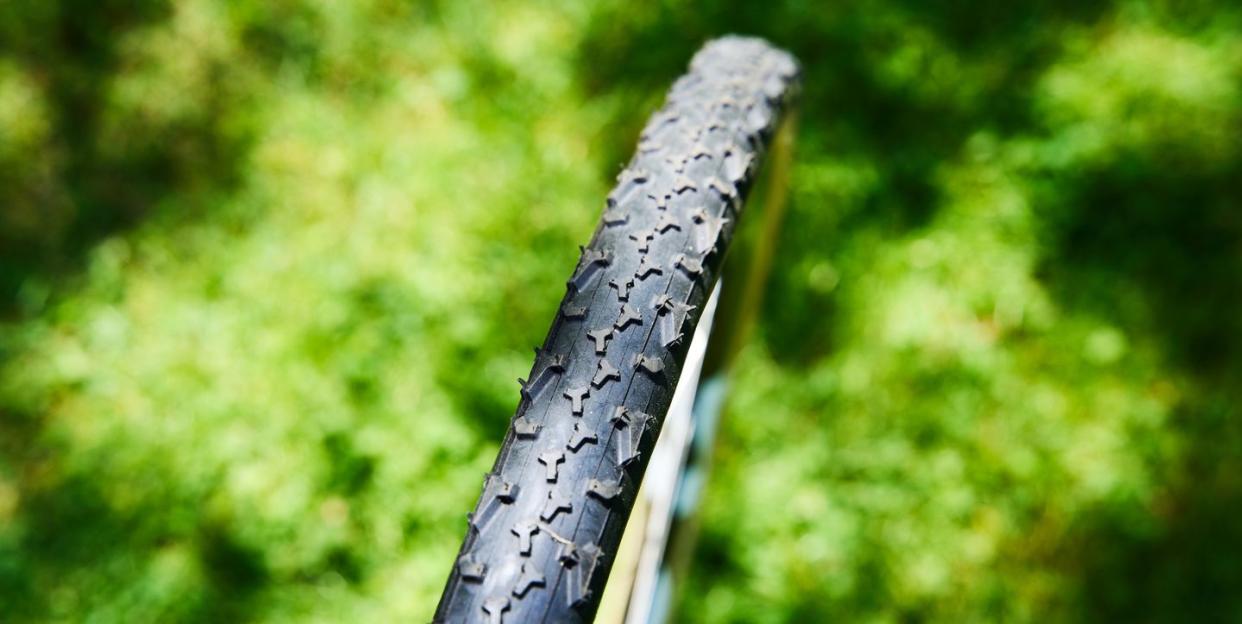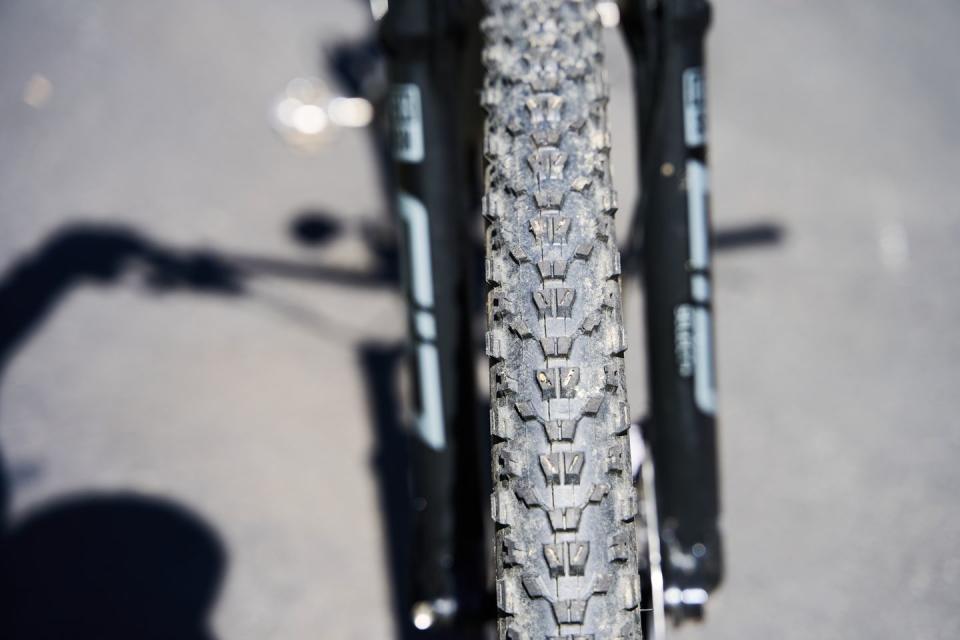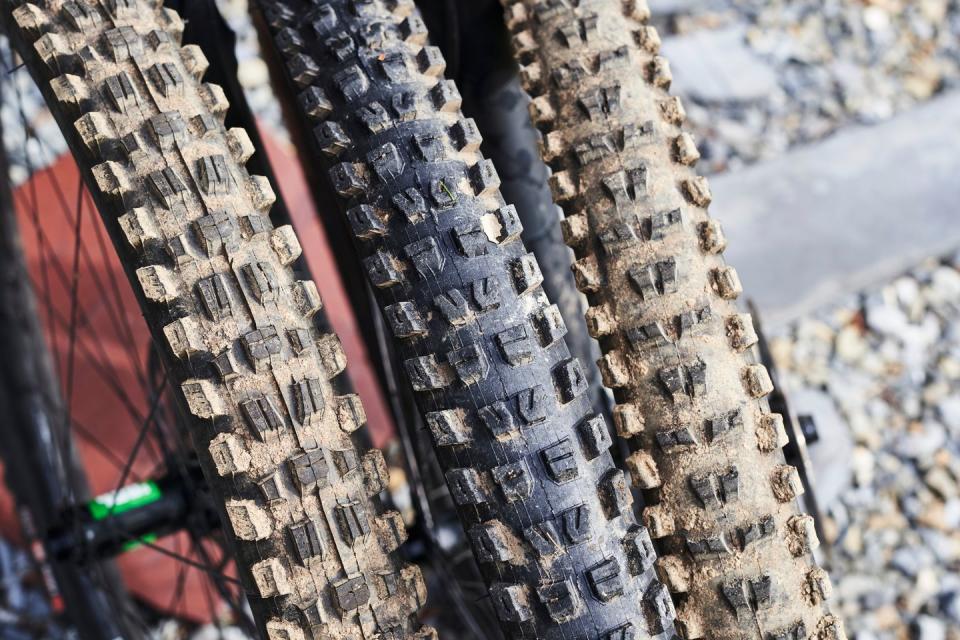Some Basic Knowledge Will Lessen Wear and Keep Your Tires Moving Longer

"Hearst Magazines and Yahoo may earn commission or revenue on some items through the links below."
Perhaps one of the most overlooked parts of ongoing bike maintenance is the wear and tear we put on our tires. Plus, finding dependable knowledge about what to look for when assessing your two-wheeled tread isn’t as readily available.
However, it’s vitally important to learn some basics about bike tire wear and the condition of what you’re riding on before you head out.
“Tires that are too worn, have too many cuts and/or a cut that is susceptible of getting something in it are so dangerous and need replacing as a matter of urgency, so it’s best to really pay attention to your tyres on a regular basis,” says Jamie Burrow, head of product at Ribble Cycles.
Having some simple knowledge (and a couple of tools) in hand will give you peace of mind on your next ride, so you can venture and explore in confidence.
What to look for with bike tire wear
Trek aftermarket marketing manager Alex Applegate says that a simple visual inspection can offer plenty of insight into the condition of your tread.
“Look for cracking or creases in the sidewall, visible wear in the tread and any sort of punctures or tears that could compromise either tire’s ability to hold air,” he says.
If you’re not regularly inflating your tires to their proper pressure (which is easily identifiable by a PSI number on the sidewall), you’ll probably notice more wear on the sides of the tire first as opposed to the middle. Bike tires can wear down pretty far and still classify as “rideable,” but understand that less tread means less grip, and that can turn into a nasty twist or tumble if you have to correct suddenly while biking.
If you find any significant holes or cuts in your tire, it’s time to replace it. It’s not worth the gamble to try to ride on something that’s not safe or could go flat shortly into your ride, even if you’re adequately prepared to fix it roadside (more on that below).
How to lessen tire wear over time

One of the most important things you can do before every ride is a simple air pressure check. If you ride with any sort of regularity, it’s worth investing in an air pump so you can have proper inflation every time. (Also make sure to learn how to use the pump correctly based on which type of inflation head your tires have—easily findable through your owner’s manual or a quick online search).
Burrow also says bad road surfaces and bad weather will accelerate wear and tear. This mainly applies to road and commuter tires, but if you’re of the gravel or mountain discipline, this may not necessarily apply, and you’re probably riding on a tougher tire that can handle uneven surfaces, anyway.
If you are sticking mainly to asphalt and pavement, you may find your tires wearing faster if you end up riding on a side bike lane more often than the middle of the road itself.
“Those that ride more in and toward the side of the road than on it would be more averse to picking up debris, (and developing) cuts and punctures,” he adds.
If you’re riding with rim brakes, inspect them regularly to ensure the pads aren’t hitting the wheel rim, potentially causing damage to the sidewall. If you notice any sort of uneven or abnormal interaction between the pad and the wheel, you may need a cable or brake adjustment, which may require a trip to the bike shop. This is also a great time to hold your bike up and spin each wheel to ensure each one is moving evenly. Any abnormal shifts could wear tires faster in a specific spot.
How long should different bike tires last?

According to Applegate, a good bike tire should last “well over” 1,000 miles when properly inflated and ridden in good conditions.
He also advises to think about the type of riding you do as that will greatly affect the life of your tires.
“The rougher the roads and more aggressive the rider, the faster the tires will wear. A fast one-hour ride where you cover 20 miles will have more wear than a slow one-hour ride around the neighborhood where you may only cover 10 miles,” he says.
As mentioned above, gravel and mountain bikers may find that the uneven terrain they ride (and the unpredictability that comes with it) grills tires faster than the standard commuter or road ride. That being said, tackling long distances on asphalt can lead to more wear and tear just by nature of use.
Tubes and going tubeless
The majority of entry-level and everyday bikes are set up with tubes inside the tire, meaning there’s an inflatable rubber tube that holds air, and thus, the tire’s shape.
As the name suggests, “tubeless” tires are a specific setup that includes a sealant in the tire to ensure it holds air, and the absence of a tube means that even if you get a puncture, you may still be able to ride on the tire as the sealant will fill the gap. Tubeless options are often on higher-end models, and you’ll need to make sure your specific tire can support this option. Your wheels also need to be “tubeless-ready,” which is easy to identify based on the model’s specifications.
Additionally, Pirelli global cycling marketing manager Samuele Bressan recommends replacing the sealant in tubeless tires twice a year to maintain optimal riding. He’s also a big advocate of making the switch overall.
“(Consider) the benefits: You’re more protected against punctures, have better handling, are more comfortable, faster rolling and have more grip,” he says. “Think that all other vehicles (two or four wheels) are running tubeless … for a reason.”
E-bikes and tire wear
Most lower-level e-bikes are heavier, which means more and faster wear on those tires. Bike companies are starting to produce e-bike-specific tires, which, according to Applegate, have additional puncture protections and more sidewall support to better handle the demands of assisted riding.
In contrast, Bressan notes that although brands have started to test e-bike tires independently to certain standards, there are no specific regulations for the vast majority of commercially available tires “rated” for e-bikes, so as he sees it, much of it is just marketing.
“This has become so established in the consumer mind, but in reality, it’s not a requirement you need to have,” he says.
In any case, it’s still important to pay extra attention to the wear on your e-bike’s tires as you’ll at least potentially notice different kinds of wear, which may call for a different replacement schedule than an acoustic bike. Also, keep in mind that should you experience a flat on the rear tire with a wheel hub-mounted motor, it’s almost impossible to remove the motor properly and do that replacement roadside, so you’re likely calling for help at that point.
Tools to have for bike tire wear
Whether or not you’re going to learn how to replace bike tires on your own, it’s still a great idea to spend some time learning how to fix a flat and having a small set of tools available when it happens.
If you do experience a flat while riding, the first thing to do is get to a safe spot where you can assess the damage and take care of the issue out of the way of bike and car traffic. Once you learn the basics, fixing a flat should only take a few minutes.
Bike levers: A good set of bike levers will help you get the tire off and on without strain.
Mini Hex Wrench Set: Hex keys are great for removing and replacing wheels on an axle, but can also do a number of other simple bike repairs in real-time, letting you get on with your ride much quicker.
C02 Inflator: A stop-gap option to fill your tire to get you back home.
Portable tire pump: A portable pump will provide longer-lasting inflation as opposed to C02 (better for bike touring and endurance rides), and quality options often come with an attachment that will secure the pump to your bike frame.
Travel sealant: Sealant will fail from time to time, and you’ll need to patch it roadside. Several brands make convenient travel size containers.
You Might Also Like

